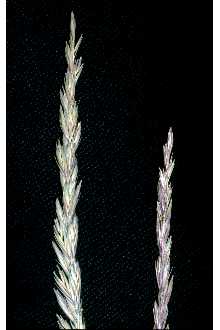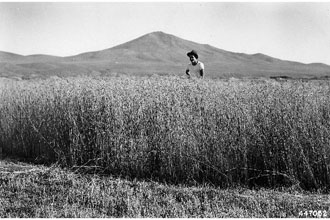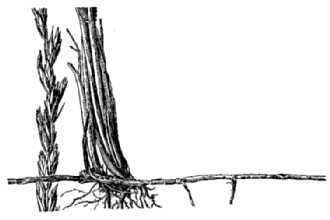Beardless Wildrye
Scientific Name: Leymus triticoides (Buckley) Pilg.

| General Information | |
|---|---|
| Usda Symbol | LETR5 |
| Group | Monocot |
| Life Cycle | Perennial |
| Growth Habits | Graminoid |
| Native Locations | LETR5 |
Plant Guide
BEARDLESS
WILDRYE Leymus triticoides (Buckl.) Pilger Plant Symbol = LETR5 Contributed by: USDA NRCS California State Office and Lockeford Plant Materials Center, California
Alternate Names
Creeping wildrye
Uses
Beardless wildrye is used for soil stabilization on channel, stream and river slopes and restoration of roadside, riparian and rangeland areas. It is also used for forage or cover on wet or wet-saline-alkaline soils. This includes pastureland; saline-affected, irrigated cropland; and dryland, saline-seep discharge areas. In good soils, roots may go down 10 ft. It also lays flat during high water flow periods, thus allowing full water flow while still protecting the streambank. It provides high quality waterfowl and upland game nesting habitat. This species’ flood tolerance is excellent. It is found in flood plains that receive prolonged inundation Ethnobotanic uses: Beardless wildrye seed was used by Native Americans for food.
Status
Please consult the PLANTS Web site and your State Department of Natural Resources for this plant’s current status (e.g. threatened or endangered species, state noxious status, and wetland indicator values).
Description
General: Grass Family (Poaceae). Beardless wildrye is a cool-season, perennial, sod-forming native grass. It is a long grass that is typically tall and strongly rhizomatous. The stems are often smooth, but can be hairy. Leaf blades are green to blue-green and 2.5-4 mm wide with a slightly rough upper surface. Robert Mohlenbrock @ USDA NRCS PLANTS Database
Distribution
Beardless wildrye is distributed at low and medium elevations from Montana to Washington and south to west Texas and California. For current distribution, please consult the Plant Profile page for this species on the PLANTS Web site.
Adaptation
This grass grows on mostly heavy soils in riparian areas, bottomlands, valleys, foothills, mountain flats and meadows from coastal marshes to high elevations.
Establishment
Beardless wildrye can be established by seed, sod or rhizomes.
Management
If managed properly, it will develop into large patches or colonies, but cultivation restricts it. It can be valuable forage in certain areas, especially on meadows that become dry, where it is grazed through most of the summer. It resists trampling and recovers well from grazing. At lower elevations it is coarser for grazing than annuals. It will also tolerate mowing well, especially if mowed late in the growing season and if not mowed too short. It is also fire tolerant. After mowing or burning it begins green-up in the late summer if deep soil moisture is adequate. In spite of delayed germination of up to one month and poor seedling vigor, it can compete sufficiently with weeds and annual grasses to dominate a site in the second year.
Pests and Potential Problems
None
Seeds and Plant Production
Plant Production , Use soil moisture sensors to measure the soil moisture of Beardless Wildrye.
Plant Production
Beardless wildrye seed matures in late spring to early summer. Most wild ecotypes flower but do not produce seed. If viable seed is present, it can be collected for 4-20 weeks. The seed does not shatter as easily as many other species. There are between 110,000 and 130,000 seeds/lb. and if planted at a rate of 1 lb./acre there would be approximately 2.8 seeds/square foot. Cultivars, Improved, and Selected Materials (and area of origin) ‘Rio’ Cultivar- This cultivar was selected at the NRCS Plant Materials Center, Lockeford, California. It was collected in 1973 from a native stand in Stratford, Kings County, CA. Seed and rhizomes were harvested from test plots at the Lockeford Plant Materials Center and used for testing throughout the Mediterranean climate in California. It demonstrated superior seed viability and initial sod establishment in comparison with about 12 other California native collections. ‘Shoshone’ Cultivar- This cultivar was collected in 1958 from a stand at Riverton, WY fairgrounds. The stand was possibly a seeded stand established in the 1940s from an unknown source. It is an exceptionally leafy, fine stemmed, high forage producer; rhizomes especially vigorous, extending 1.8 m in one season; leaves broad, lax, and dark green. Comparatively high seed production for this species; seed plump and heavy. Shoshone is used primarily for forage, stabilization, or cover on wet or wet-saline-alkaline soils. This included pastureland; saline-affected, irrigated cropland; and dryland saline-seep discharge areas. Seed dormancy requires fall dormant planting in moist seedbed. Contact your local Natural Resources
Conservation
Service (formerly Soil Conservation Service) office for more information. Look in the phone book under ”United States Government.” The Natural Resources Conservation Service will be listed under the subheading “Department of Agriculture.”
Plant Traits
Growth Requirements
| Fire Tolerance | High |
|---|---|
| Cold Stratification Required | Yes |
| Drought Tolerance | High |
| Drought Tolerance | High |
| Drought Tolerance | High |
| Fertility Requirement | Medium |
| Fertility Requirement | Medium |
| Fertility Requirement | Medium |
| Fire Tolerance | High |
| Cold Stratification Required | Yes |
| Fire Tolerance | High |
| Frost Free Days, Minimum | 110 |
| Frost Free Days, Minimum | 150 |
| Frost Free Days, Minimum | 90 |
| Hedge Tolerance | None |
| Hedge Tolerance | None |
| Hedge Tolerance | None |
| Adapted to Medium Textured Soils | Yes |
| Adapted to Coarse Textured Soils | No |
| Adapted to Coarse Textured Soils | Yes |
| Adapted to Coarse Textured Soils | Yes |
| Adapted to Fine Textured Soils | Yes |
| Adapted to Fine Textured Soils | Yes |
| Adapted to Fine Textured Soils | Yes |
| Adapted to Medium Textured Soils | Yes |
| Adapted to Medium Textured Soils | Yes |
| Temperature, Minimum (°F) | -43 |
| Anaerobic Tolerance | High |
| Anaerobic Tolerance | High |
| Anaerobic Tolerance | High |
| CaCO3 Tolerance | High |
| CaCO3 Tolerance | High |
| CaCO3 Tolerance | High |
| Cold Stratification Required | No |
| Moisture Use | High |
| Temperature, Minimum (°F) | -43 |
| Temperature, Minimum (°F) | -43 |
| Shade Tolerance | Intolerant |
| Shade Tolerance | Intolerant |
| Shade Tolerance | Intolerant |
| Salinity Tolerance | High |
| Salinity Tolerance | High |
| Salinity Tolerance | High |
| Root Depth, Minimum (inches) | 10 |
| Root Depth, Minimum (inches) | 10 |
| Root Depth, Minimum (inches) | 10 |
| Precipitation, Minimum | 7 |
| Precipitation, Minimum | 7 |
| Precipitation, Minimum | 7 |
| Precipitation, Maximum | 60 |
| Precipitation, Maximum | 24 |
| Moisture Use | High |
| Moisture Use | Low |
| pH, Maximum | 9.0 |
| pH, Maximum | 9.0 |
| pH, Maximum | 9.0 |
| pH, Minimum | 6.0 |
| pH, Minimum | 6.0 |
| pH, Minimum | 6.6 |
| Planting Density per Acre, Maxim | 11000 |
| Planting Density per Acre, Maxim | 11000 |
| Planting Density per Acre, Maxim | 11000 |
| Planting Density per Acre, Minim | 3000 |
| Planting Density per Acre, Minim | 3000 |
| Planting Density per Acre, Minim | 3000 |
| Precipitation, Maximum | 60 |
Morphology/Physiology
| Active Growth Period | Spring, Summer, Fall |
|---|---|
| Toxicity | None |
| Toxicity | None |
| Toxicity | None |
| Shape and Orientation | Erect |
| Shape and Orientation | Erect |
| Foliage Color | Green |
| Fire Resistant | No |
| Fire Resistant | No |
| Fire Resistant | No |
| Flower Color | Yellow |
| Flower Color | Yellow |
| Flower Color | Yellow |
| Flower Conspicuous | No |
| Flower Conspicuous | No |
| Flower Conspicuous | No |
| Fall Conspicuous | No |
| Foliage Color | Green |
| Foliage Color | Green |
| Foliage Porosity Summer | Dense |
| Foliage Porosity Summer | Moderate |
| Foliage Porosity Summer | Moderate |
| Foliage Porosity Winter | Porous |
| Foliage Porosity Winter | Porous |
| Foliage Porosity Winter | Porous |
| Bloat | None |
| Shape and Orientation | Erect |
| Active Growth Period | Spring, Summer, Fall |
| Active Growth Period | Spring, Summer, Fall |
| After Harvest Regrowth Rate | Moderate |
| After Harvest Regrowth Rate | Moderate |
| After Harvest Regrowth Rate | Moderate |
| Bloat | None |
| Bloat | None |
| Resprout Ability | No |
| C:N Ratio | Medium |
| C:N Ratio | Medium |
| C:N Ratio | Medium |
| Coppice Potential | No |
| Coppice Potential | No |
| Coppice Potential | No |
| Fall Conspicuous | No |
| Fall Conspicuous | No |
| Lifespan | Long |
| Known Allelopath | No |
| Known Allelopath | No |
| Known Allelopath | No |
| Leaf Retention | No |
| Leaf Retention | No |
| Leaf Retention | No |
| Lifespan | Long |
| Lifespan | Long |
| Foliage Texture | Coarse |
| Low Growing Grass | No |
| Low Growing Grass | No |
| Low Growing Grass | No |
| Nitrogen Fixation | None |
| Nitrogen Fixation | None |
| Nitrogen Fixation | None |
| Resprout Ability | No |
| Resprout Ability | No |
| Height, Mature (feet) | 3.0 |
| Height, Mature (feet) | 3.0 |
| Foliage Texture | Coarse |
| Foliage Texture | Coarse |
| Fruit/Seed Color | Brown |
| Fruit/Seed Color | Brown |
| Fruit/Seed Color | Brown |
| Fruit/Seed Conspicuous | No |
| Fruit/Seed Conspicuous | No |
| Growth Form | Rhizomatous |
| Growth Form | Rhizomatous |
| Growth Form | Rhizomatous |
| Growth Rate | Rapid |
| Growth Rate | Rapid |
| Growth Rate | Rapid |
| Height, Mature (feet) | 3.0 |
| Fruit/Seed Conspicuous | No |
Reproduction
| Seed per Pound | 170304 |
|---|---|
| Propagated by Tubers | No |
| Propagated by Tubers | No |
| Propagated by Tubers | No |
| Propagated by Sprigs | Yes |
| Propagated by Sprigs | Yes |
| Propagated by Sprigs | Yes |
| Propagated by Sod | No |
| Propagated by Sod | No |
| Propagated by Sod | No |
| Propagated by Seed | Yes |
| Propagated by Seed | Yes |
| Propagated by Seed | Yes |
| Propagated by Cuttings | No |
| Propagated by Cuttings | No |
| Seed per Pound | 170304 |
| Fruit/Seed Period End | Summer |
| Seed per Pound | 170304 |
| Seed Spread Rate | Slow |
| Seed Spread Rate | Slow |
| Seed Spread Rate | Slow |
| Seedling Vigor | Low |
| Seedling Vigor | Low |
| Seedling Vigor | Low |
| Small Grain | No |
| Small Grain | No |
| Small Grain | No |
| Vegetative Spread Rate | Rapid |
| Vegetative Spread Rate | Rapid |
| Vegetative Spread Rate | Rapid |
| Propagated by Corm | No |
| Propagated by Cuttings | No |
| Bloom Period | Late Spring |
| Bloom Period | Late Spring |
| Bloom Period | Late Spring |
| Commercial Availability | Routinely Available |
| Commercial Availability | Routinely Available |
| Commercial Availability | Routinely Available |
| Fruit/Seed Abundance | High |
| Fruit/Seed Abundance | Low |
| Fruit/Seed Abundance | Low |
| Fruit/Seed Period Begin | Spring |
| Fruit/Seed Period Begin | Summer |
| Fruit/Seed Period Begin | Summer |
| Fruit/Seed Period End | Summer |
| Fruit/Seed Period End | Summer |
| Fruit/Seed Persistence | No |
| Fruit/Seed Persistence | No |
| Propagated by Corm | No |
| Propagated by Corm | No |
| Propagated by Container | No |
| Propagated by Container | No |
| Propagated by Container | No |
| Propagated by Bulb | No |
| Propagated by Bulb | No |
| Propagated by Bulb | No |
| Propagated by Bare Root | No |
| Propagated by Bare Root | No |
| Propagated by Bare Root | No |
| Fruit/Seed Persistence | No |
Suitability/Use
| Palatable Browse Animal | Medium |
|---|---|
| Palatable Graze Animal | Medium |
| Palatable Graze Animal | Medium |
| Palatable Graze Animal | Medium |
| Palatable Human | No |
| Palatable Human | No |
| Palatable Human | No |
| Post Product | No |
| Post Product | No |
| Post Product | No |
| Protein Potential | Medium |
| Protein Potential | Medium |
| Protein Potential | Medium |
| Pulpwood Product | No |
| Pulpwood Product | No |
| Pulpwood Product | No |
| Veneer Product | No |
| Veneer Product | No |
| Veneer Product | No |
| Lumber Product | No |
| Berry/Nut/Seed Product | No |
| Berry/Nut/Seed Product | No |
| Berry/Nut/Seed Product | No |
| Christmas Tree Product | No |
| Christmas Tree Product | No |
| Christmas Tree Product | No |
| Fodder Product | Yes |
| Fodder Product | Yes |
| Fodder Product | Yes |
| Palatable Browse Animal | Medium |
| Lumber Product | No |
| Lumber Product | No |
| Naval Store Product | No |
| Naval Store Product | No |
| Naval Store Product | No |
| Nursery Stock Product | No |
| Nursery Stock Product | No |
| Nursery Stock Product | No |
| Palatable Browse Animal | Medium |


